light HONDA S2000 2000 1.G Service Manual
[x] Cancel search | Manufacturer: HONDA, Model Year: 2000, Model line: S2000, Model: HONDA S2000 2000 1.GPages: 273, PDF Size: 21.58 MB
Page 115 of 273
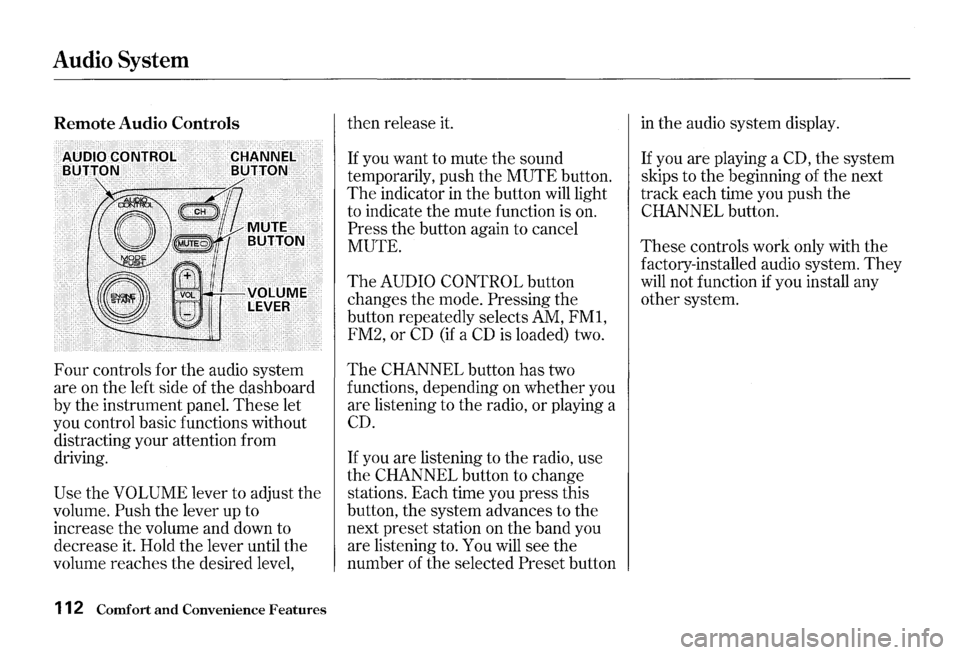
Audio System
Remote Audio Controls
AUDIO CbNTROL··.······· BUTTON ....
Four controls for the audio system
are on the left side of the dashboard
by the instrument panel.
These let
you control basic functions without
distracting your attention from
driving.
Use the VOLUME lever to adjust the
volume.
Push the lever up to
increase the volume and down to
decrease it. Hold the lever until the
volume reaches the desired level,
112 Comfort and Convenience Features
then release it.
If you want to mute the sound
temporarily, push the
MUTE button.
The indicator in the button will light
to indicate the mute function is on.
Press the button again to cancel
MUTE.
The AUDIO CONTROL button
changes the mode.
Pressing the
button repeatedly selects AM,
FMl,
FM2, or CD (if a CD is loaded) two.
The CHANNEL button has two
functions, depending on whether you
are listening to the radio,
or playing a
CD.
If you are listening to the radio, use
the
CHANNEL button to change
stations. Each time you press this
button, the system advances to the
next preset station on the band you
are listening to. You will see the
number of the selected
Preset button
in the audio system display.
If you are playing a CD, the system
skips to the beginning of the next
track each time you push the
CHANNEL button.
These controls work only with the
factory-installed audio system.
They
will not function if you install any
other system.
Page 119 of 273
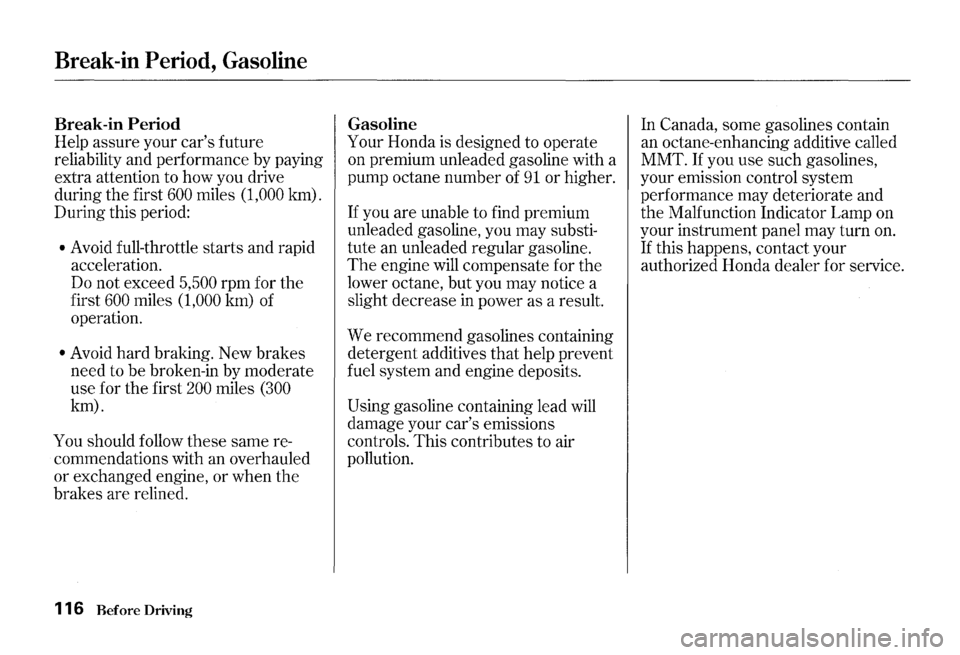
Break-in Period, Gasoline
Break-in Period
Help assure your car's future
reliability and performance by paying
extra attention to how you drive
during the first
600 miles (1,000 km).
During this period:
• Avoid full-throttle starts and rapid
acceleration.
Do not exceed 5,500 rpm for the
first
600 miles (1,000 km) of
operation.
• Avoid hard braking. New brakes
need to be broken-in by moderate
use for the first
200 miles (300
km).
You should follow these same re
commendations with an overhauled
or exchanged engine, or when the
brakes are relined.
116 Before Driving
Gasoline
Your Honda is designed to operate
on premium unleaded gasoline with a
pump octane number of
91 or higher.
If you are unable to find premium
unleaded gasoline, you may substi
tute an unleaded regular gasoline.
The engine will compensate for the
lower octane, but you may notice a
slight decrease in power as a result.
We recommend gasolines containing
detergent additives
that help prevent
fuel system and engine deposits.
Using gasoline containing lead will
damage your car's emissions
controls. This contributes to air
pollution. In
Canada, some
gasolines contain
an octane-enhancing additive called
MMT.
If you use such gasolines,
your emission control system
performance may deteriorate and
the Malfunction Indicator Lamp on
your instrument panel may turn on.
If this happens, contact your
authorized Honda dealer for service.
Page 121 of 273
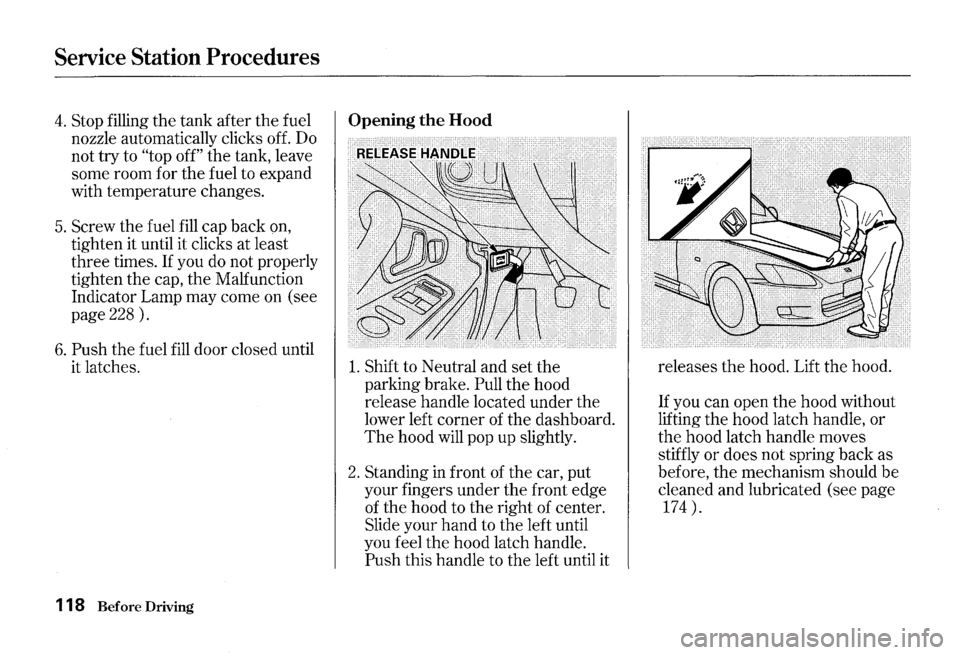
Service Station Procedures
4. Stop filling the tank after the fuel
nozzle automatically clicks off. Do
not try to
"top off" the tank, leave
some room for the fuel to expand
with temperature changes.
5. Screw the fuel fill cap back on,
tighten it until it clicks at least
three times.
If you do not properly
tighten the cap, the Malfunction
Indicator Lamp may come on (see
page
228 ).
6. Push the fuel fill door closed until
it latches.
118 Before Driving
Opening the Hood
1. Shift to Neutral and set the
parking brake.
Pull the hood
release handle located under the
lower left corner of the dashboard.
The hood will pop up slightly.
2. Standing in front of the car, put
your fingers under the front edge
of the hood to the right of center.
Slide your hand to the left until
you feel the hood latch handle.
Push this handle to the left until it releases
the hood.
Lift the hood.
If you can open the hood without
lifting the hood latch handle, or
the hood latch handle moves
stiffly or does not spring back as
before, the mechanism should
be
cleaned and lubricated (see page
174 ).
Page 122 of 273
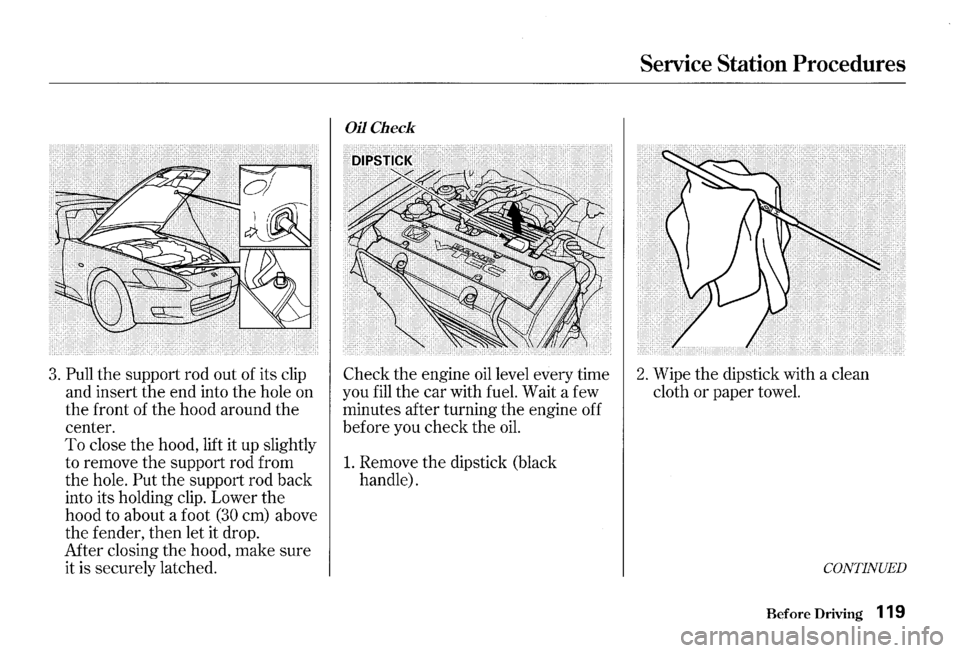
3. Pull the support rod out of its clip
and insert
the end into the hole on
the front of the hood around the
center.
To close the hood, lift it up slightly
to remove
the support rod from
the hole. Put the support rod back
into its holding clip. Lower
the
hood to about a foot (30 em) above
the fender, then let it drop.
After closing
the hood, make sure
it is securely latched.
Oil Check
Check the engine oil level every time
you
fill the car with fuel. Wait a few
minutes after turning
the engine off
before you check
the oil.
1. Remove the dipstick (black
handle).
Service Station Procedures
2. Wipe the dipstick with a clean
cloth
or paper towel.
CONTINUED
Before Driving 119
Page 125 of 273
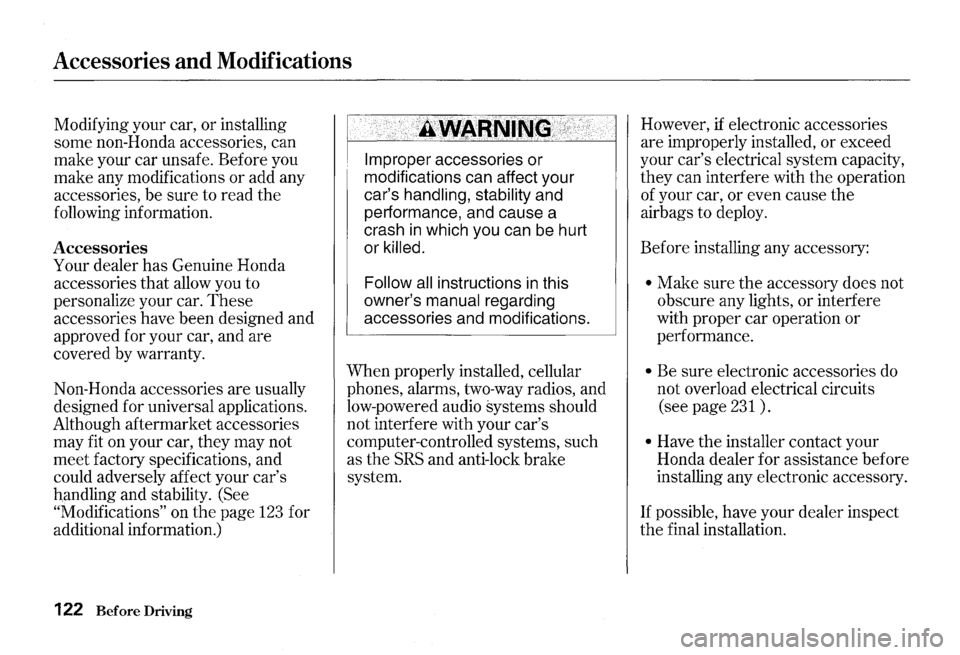
Accessories and Modifications
Modifying your car, or installing
some non-Honda accessories, can
make your car unsafe. Before you
make any modifications or add any
accessories, be sure to read the
following information.
Accessories
Your dealer has Genuine Honda
accessories that allow you to
personalize your car.
These
accessories have been designed and
approved for your car, and are
covered by warranty.
Non-Honda accessories are usually
designed for universal applications.
Although aftermarket accessories
may fit on your car, they may not
meet factory specifications, and
could adversely affect your car's
handling and stability. (See
"Modifications" on the page 123 for
additional information.)
122 Before Driving
Improper accessories or
modifications can affect your
car's
handling, stability and
performance, and cause a
crash
in which you can be hurt
or
killed.
Follow all
instructions in this
owner's
manual regarding
accessories and modifications.
When properly installed, cellular
phones, alarms, two-way radios, and
low-powered audio systems should
not interfere with your car's
computer-controlled systems, such
as the
SRS and anti-lock brake
system. However,
if electronic
accessories
are improperly installed, or exceed
your car's electrical system capacity,
they can interfere with the operation
of your car, or even cause the
airbags to deploy.
Before installing any accessory:
• Make sure the accessory does not
obscure any lights,
or interfere
with proper car operation or
performance.
• Be sure electronic accessories do
not overload electrical circuits
(see page 231).
• Have the installer contact your
Honda dealer for assistance before
installing any electronic accessory.
If possible, have your dealer inspect
the final installation.
Page 127 of 273
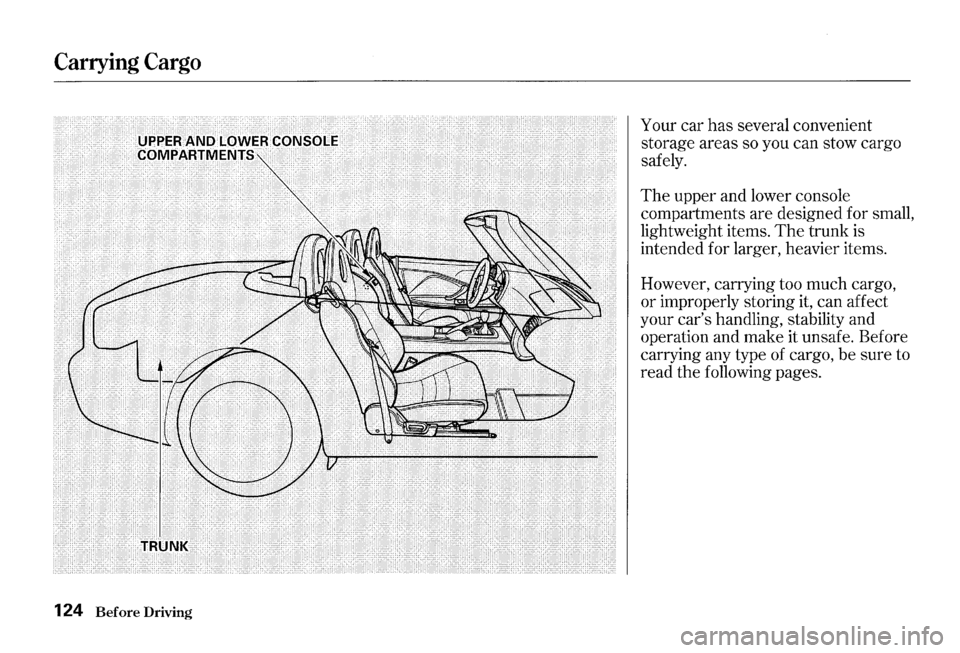
Carrying Cargo
124 Before Driving
Your car has several convenient
storage areas so you can stow cargo
safely.
The upper and lower console
compartments are designed for small,
lightweight items.
The trunk is
intended for larger, heavier items.
However, carrying too much cargo,
or improperly storing
it, can affect
your car's handling, stability and
operation and make it unsafe. Before
carrying any type of cargo, be sure to
read the following pages.
Page 133 of 273
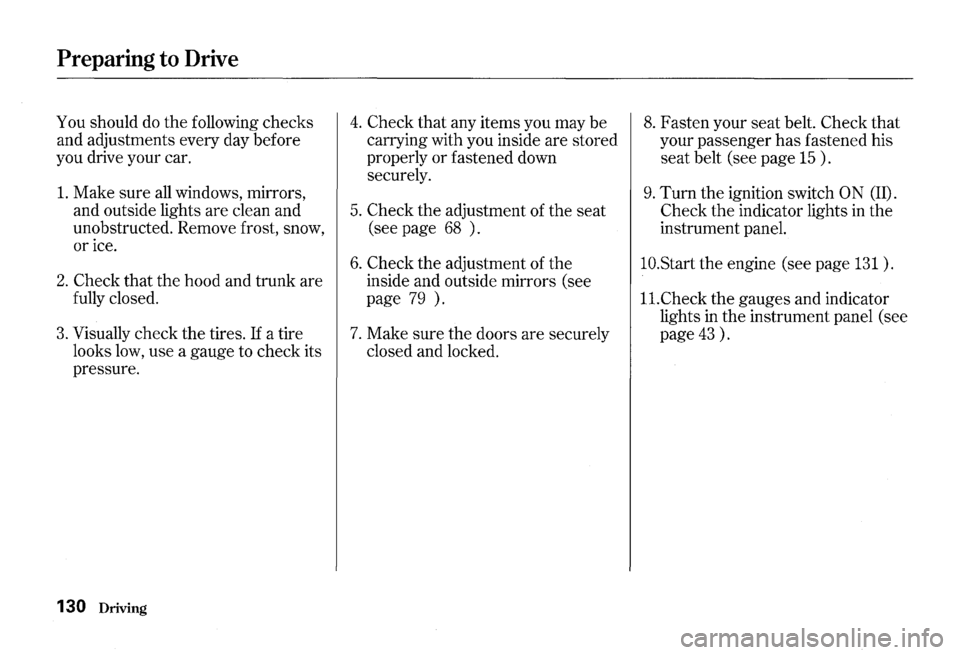
Preparing to Drive
You should do the following checks
and adjustments every day before
you drive
your car.
1. Make sure all windows, mirrors,
and outside lights
are clean and
unobstructed. Remove frost, snow,
or ice.
2. Check that the hood and trunk are
fully closed.
3. Visually check the tires. If a tire
looks low,
use a gauge to check its
pressure.
130 Driving
4. Check that any items you may be
carrying with you inside are stored
properly or fastened down
securely.
5. Check the adjustment of the seat
(see page 68 ) .
6. Check the adjustment of the
inside and outside mirrors (see
page
79 ).
7. Make sure the doors are securely
closed and locked.
8. Fasten your seat belt. Check that
your passenger has fastened his
seat belt (see page 15 ) .
9. Turn the ignition switch ON (II).
Check
the indicator lights in the
instrument panel.
10.Start
the engine (see page 131 ) .
1l.Check the gauges and indicator
lights in
the instrument panel (see
page
43 ).
Page 138 of 273
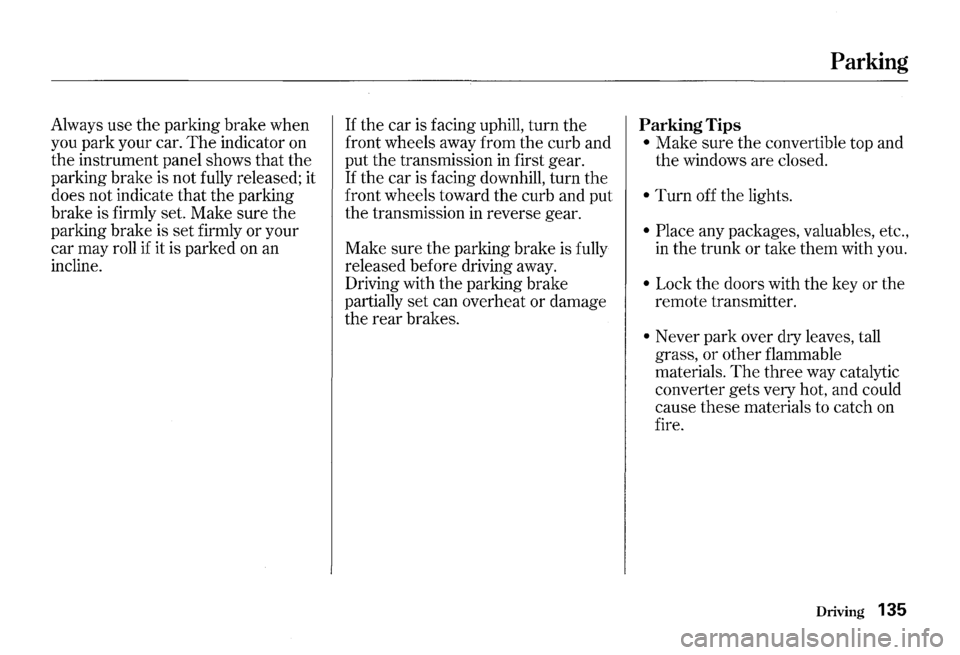
Always use the parking brake when
you park your car.
The indicator on
the instrument panel shows that the
parking brake is not fully released; it
does not indicate that the parking
brake is firmly set. Make sure the
parking brake is set firmly or your
car may roll
if it is parked on an
incline. If
the car is facing uphill, turn the
front wheels away from the curb and
put
the transmission in first gear.
If the car is facing downhill, turn the
front wheels toward the curb and put
the transmission
in reverse gear.
Make sure the parking brake is fully
released before driving away.
Driving with the parking brake
partially set can overheat or damage
the rear brakes.
Parking
Parking Tips
• Make sure the convertible top and
the windows are closed.
• Turn off the lights.
• Place any packages, valuables, etc.,
in the trunk or take them with you.
• Lock the doors with the key or the
remote transmitter.
• Never park over dry leaves, tall
grass, or other flammable
materials.
The three way catalytic
converter gets very hot, and could
cause these materials to catch on
fire.
Driving 135
Page 139 of 273
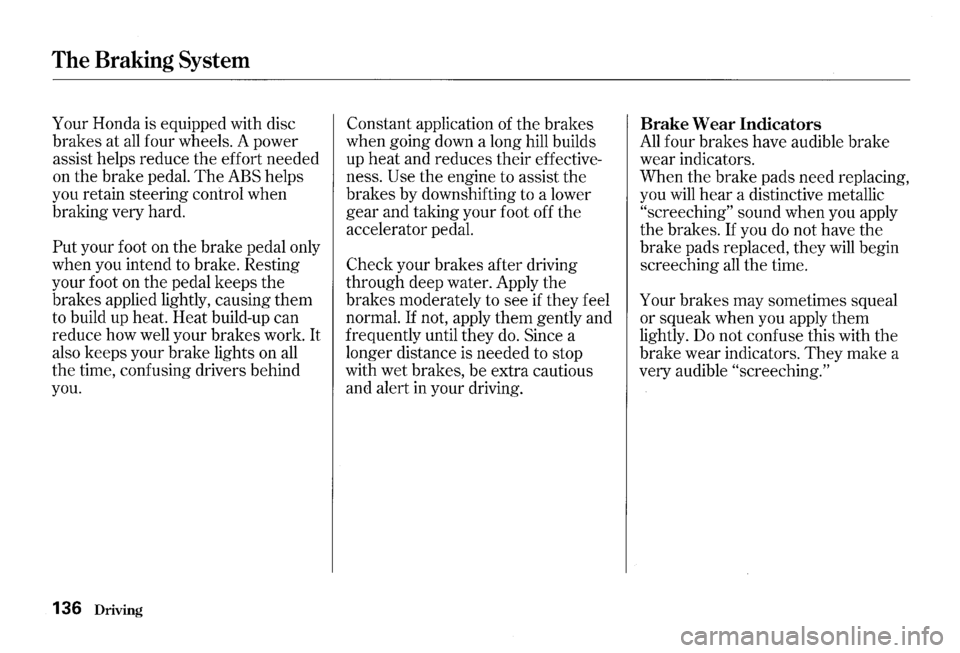
The Braking System
Your Honda is equipped with disc
brakes at
all four wheels. A power
assist helps reduce the effort needed
on the brake pedal.
The ABS helps
you retain steering control when
braking very hard.
Put your foot on the brake pedal only
when you intend to brake. Resting
your foot on the pedal keeps the
brakes applied lightly, causing them
to build up heat. Heat build-up can
reduce how well your brakes work.
It
also keeps your brake lights on all
the time, confusing drivers behind
you.
136 Driving
Constant application of the brakes
when going down a long hill builds
up heat and reduces their effective
ness.
Use the engine to assist the
brakes by downshifting to a lower
gear and taking your foot off the
accelerator pedal.
Check your brakes after driving
through deep water. Apply the
brakes moderately to see
if they feel
normal.
If not, apply them gently and
frequently until they
do. Since a
longer distance is needed to stop
with wet brakes, be extra cautious
and alert in your driving.
Brake Wear Indicators
All four brakes have audible brake
wear indicators.
When the brake pads need replacing,
you will
hear a distinctive metallic
"screeching" sound when you apply
the brakes.
If you do not have the
brake pads replaced, they will begin
screeching
all the time.
Your brakes may sometimes squeal
or squeak when you apply
them
lightly. Do not confuse this with the
brake wear indicators.
They make a
very audible
"screeching."
Page 143 of 273
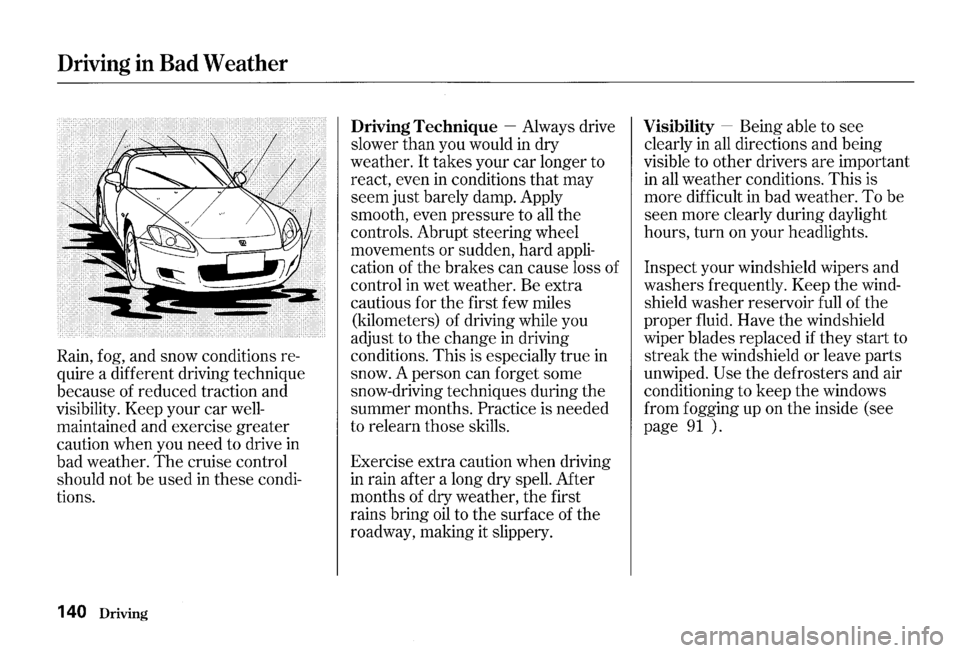
Driving in Bad Weather
Rain, fog, and snow conditions re
quire a different driving technique
because of reduced traction and
visibility. Keep your car well
maintained and exercise greater
caution when you need to drive in
bad weather.
The cruise control
should not be used in these condi
tions.
140 Driving
Driving Technique -Always drive
slower than you would
in dry
weather.
It takes your car longer to
react, even
in conditions that may
seem just barely damp. Apply
smooth, even pressure to
all the
controls. Abrupt steering wheel
movements or sudden, hard appli
cation of the brakes can cause loss of
control in wet weather. Be extra
cautious for the first few miles
(kilometers) of driving while you
adjust to the change in driving
conditions.
This is especially true in
snow. A person can forget some
snow-driving techniques during the
summer months.
Practice is needed
to relearn those skills.
Exercise extra caution when driving
in rain after a long dry spell. After
months of dry weather, the first
rains bring
oil to the surface of the
roadway, making it slippery.
Visibility -Being able to see
clearly in
all directions and being
visible to other drivers are important
in all weather conditions. This is
more difficult
in bad weather. To be
seen more clearly during daylight
hours, turn on your headlights.
Inspect your windshield wipers and
washers frequently. Keep the wind
shield washer reservoir full of the
proper fluid. Have the windshield
wiper blades replaced
if they start to
streak the windshield or leave parts
unwiped.
Use the defrosters and air
conditioning to keep the windows
from fogging up on
the inside (see
page
91 ).